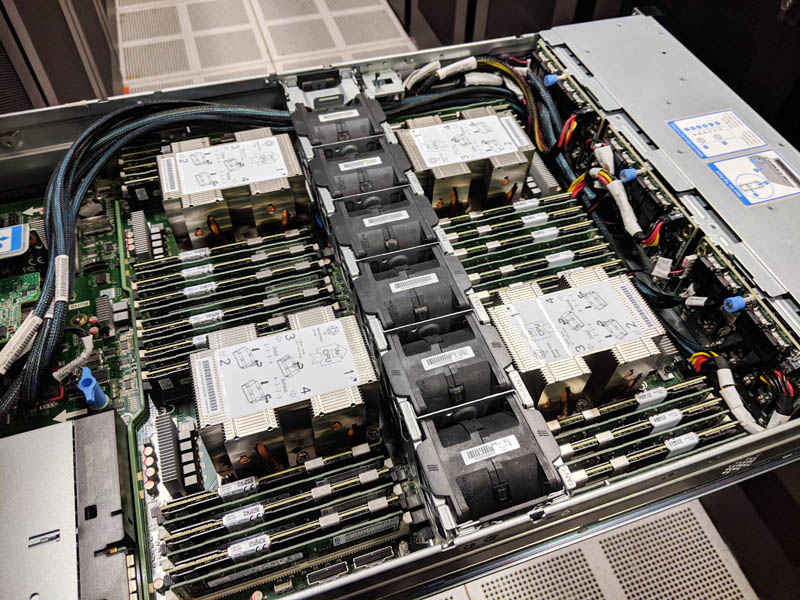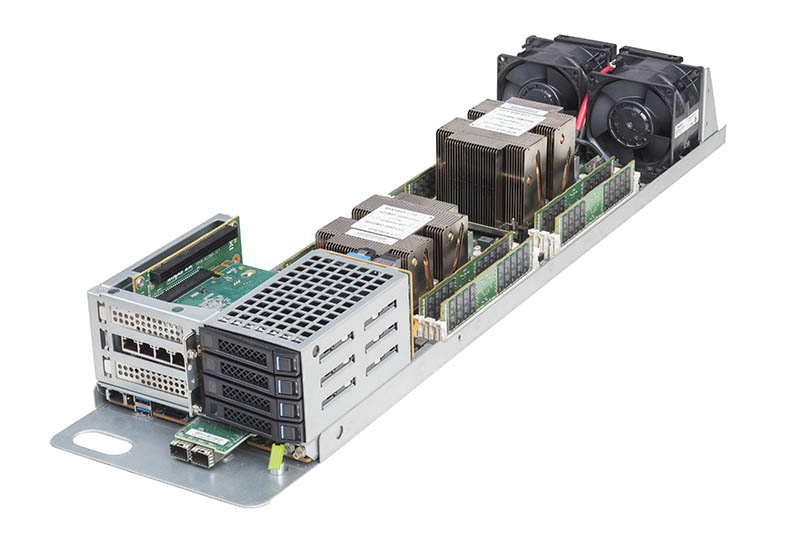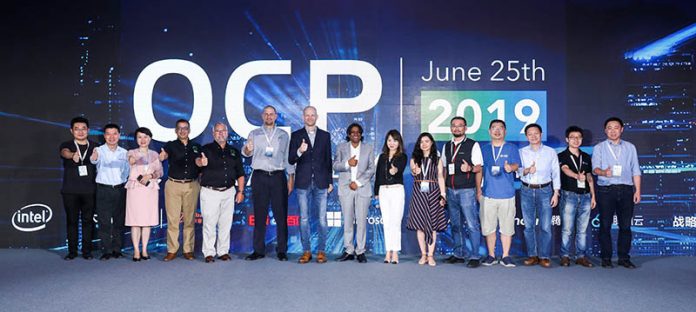The OCP Foundation has been growing rapidly along a number of vectors. It has been absorbing projects like Open19 and moving beyond hardware to software projects like OpenBMC. Aside from the scope of its projects, it is expanding geographic outreach. We covered OCP Summit 2019 in San Jose, California. I later attended the OCP Taiwan Day event during Computex 2019 which you may have seen on Twitter. The big expansion push is in China where three of the so-called “Super 7” hyper-scale companies reside alongside a growing digital economy. I wanted to do an interview around OCP China Day 2019.
Bill Carter, CTO of OCP and John Hu, CTO of Inspur, agreed to answer a few of our questions about the recent event. For the last question, we had Steve Helvie, VP of Channel Development for OCP join the conversation. In this interview, we are going to talk about OCP growth in China and some of the trends.
Introduction
Patrick Kennedy (PK): Can you tell our readers about yourself and how you got involved in OCP China 2019?
Bill Carter (BC): Before becoming the OCP CTO, I was involved with project Scorpio initiated by Tencent, Alibaba, and Baidu. I met and worked with engineers from those 3 companies and continued to maintain a relationship after joining the OCP foundation. As OCP gained worldwide recognition, there was interest from the same three companies and others to collaborate and align on common goals. Inspur helped the Foundation reconnect with China community.
John Hu (HLJ): As the CTO of Inspur, I have been working with leading CSP customers in China and worldwide over the years, including Baidu, Alibaba, Tencent, and many others. OCP is playing an important role in driving open source hardware technology for both hyper-scale datacenter customers as well as enterprise and hybrid datacenter needs. Inspur is a big believer in open sourcing and as a server leader in the China market, we are very happy to be part of the OCP China community leadership team, and excited to sponsor the OCP China day together with OCP Foundation, Intel and other OCP China community leaders.
PK: The first OCP China Day 2019 just happened in Beijing. What made you decide it was time to have an event like this?
BC: In 2017, IHS Markit conducted research to quantify the adoption of OCP specs and products. Their report indicated that Asia, and China specifically, would have the highest adoption rate of OCP products in the following 5 years. We began making plans to add a regional community in China. At the same time, we had many companies reach out to us and participate.
HLJ: China has become the 2nd largest datacenter market following the US. More importantly, heterogeneous computing including artificial intelligence and Open Edge computing for upcoming 5G era have seen growth in demand. These innovations are being discussed and turned into projects in OCP workgroups. As Bill said, many companies in China are interested in participating in those projects. Holding this OCP Day in Beijing, one of the centers of PRC IT community, was certainly the right place to have the discussions.
PK: Looking ahead to OCP China Day 2020, do you have any rough goals in terms of attendance, customers/ partners represented, or projects being featured?
BC: Ten years ago, several hyperscale companies in the US and China created new rack scale designs that achieved much better efficiency & scale for their businesses. We see that these companies are now looking at ways to converge the design features and would like to collaborate to address future needs. I would expect to see us introduce and present converged rack features, harmonized solutions for liquid cooling, common GPU/AI/ML solutions, and EDGE appliances.
HLJ: I believe AI relevant heterogeneous computing and Open Edge computing as mentioned earlier are two very interesting topics. I believe 2020 China Day will be bigger than 2019, and will continue to attract a wide range of customers and partners from different segments.
OCP in China Market Adoption
PK: How has the OCP market in China developed over the years?
HLJ: I saw growing interest in OCP market in China over the last three years. There are good examples of OCP adoption in PRC. For instance, some of the leading PRC CSPs have adopted SONiC code. Also, the OCP specification from different OCP workgroups has been recognized and applied into China OEM/ODM designs. We believe OCP will gain increased recognition by China market for their innovations and open technologies.
PK: Who is adopting OCP platforms in China, and why are they doing so? Are there companies beyond just large organizations like hyperscalers and financial firms in China looking to deploy OCP?
BC: Over the past two years we’ve seen the top hyperscale companies in China look to adopt OCP designs in certain areas of their infrastructure as they expand operations outside of China. Additionally, for the rest of the companies in China it’s still relatively new. We anticipate large enterprise, telecom providers, and CSP’s such as media content providers, SaaS-based enterprises, and large scale manufacturing companies to accelerate adoption into their infrastructure within the next two to five years.
HLJ: Besides the hyperscale datacenter customers adopting SONiC that I mentioned earlier, some hybrid datacenter customers and enterprise customers are also evaluating the OCP specs and OCP products. With the growth of 5G, we anticipate relevant OCP open edge technologies be adopted and deployed.

PK: How is the interest evolving OCP hardware platforms in China?
BC: A better question is to ask about the interest in open source, collaboration to develop cloud hardware. Both China and US companies realize the benefits of creating and adopting new technology as quickly as possible. When companies can agree on common requirements, and work together to deliver products that solve common problems, everyone benefits. OCP provides a framework for collaboration in and across the US, Europe, and Asia. As such, there is a heightened interest in participation in the projects and to adopt the work of the community and supply chain.
HLJ: OCP outlines the collaboration principles by open sourcing the specification and design collaterals for anyone who is interested in adopting. This makes the adopters much easier to adopt and the designers much quicker to innovate new designs based on the available technology. The server design, rack management and power utilization enhancement could be learned and referred from the OCP organization. We think this enables a positive cycle for the technology evolution.
PK: Is there a difference in who and why people are interested in OCP in China versus other markets?
BC: The core reasons companies are evaluating OCP are consistent across regions; such as efficiency gains, opex gains from OCP designs, vendor flexibility that comes with open designs, and visibility into community-based designs from top companies around the world. The regions do have slightly different priorities. For example, Japan and Korea are quite keen to adopt OCP into existing infrastructure due to limited space, so the OCP designs that allow companies to utilise existing racks are appealing. Europe has similar space constraints except they are quite advanced in energy efficiency and decarbonization regulations so these aspects of OCP are of top interest. North America and China are similar in desire to leverage the Community designs for scale and flexibility with an eye toward efficiency. So again, all regions have similar perspectives but slightly different ways in the ranking of those perspectives.
HLJ: From my experience and perspective, hyper-scale datacenter customers in China share common requirements with their US counterparts. Both desire to design a datacenter with scalability and resilience to expand and grow. The Datacenter democratization is becoming an interesting topic in hybrid cloud customers in China now. Therefore, the management and rack utilization efficiency of OCP are in particular interesting to those customers.
PK: How are OCP and ODCC evolving in the market?
BC: Both organizations share similar goals and have similar projects and both organizations are supported by the same supply chain. I believe that the two organizations now realize that if we coordinate our projects and collaborate, then we can lead the supply chain in the same direction and share products defined by either organization which will result in more effective use of engineering resources.
HLJ: Both organizations are Inspur’s customers and partners. I couldn’t agree with Bill more that there are areas for both organizations to collaborate together and share the best practices to benefit the ecosystem.
OCP Hardware and Software Project Focus
PK: Is the Open Accelerator Module form factor seeing adoption by the China market?
BC: Yes, Baidu joined Microsoft and Facebook to author the first draft of the specification. The project has quickly evolved to address all aspects of hardware accelerator deployment including baseboard designs and system-level thermal/mechanical considerations.
HLJ: I agree to Bill. This OAM spec addresses concerns of both the power consumption and the computing power. Inspur have high interest in this work group and we are currently leading the UBB subteam along with two other OCP members. We are hopeful that this will be adopted by the China market.
PK: What obstacles do you see ahead of broad OAM adoption, and how do you get past them?
BC: I see very few obstacles at this point. The project has strategic alignment and technical support from both US and China companies. The project has huge interest from large consumers and IP providers alike. The Open Accelerator Module (OAM) is following a similar development path as the NIC 3.0 specification that was released last year, where a penned up need is being addressed by a global community of users and suppliers.
HLJ: Don’t really see any big obstacles yet as this is really a good innovation for the end-users and designers.
PK: Looking to the edge, is the Open Edge Chassis shown at OCP China just intended for telcos? What are the other types of companies looking at the platform and why?
BC: The OCP Open Edge specification does address the requirements of central office deployment and considerations for embedded the system into weather-resistant enclosures for outdoor use. The same environmental, scale, expansion, resiliency, and remote access features will be valuable in other sectors. I would not be surprised to see deployment by retail, financial, transportation, agriculture, and industrial companies.
HLJ: Open Edge Chassis addresses the edge computing and IO expansion requirement. The edge computing is coming from Telecom carriers first, and then to CSPs and other solution providers. We are looking very closely at the innovation and customer requirement now.
PK: The OCP Foundation has been moving beyond simply hardware. How are Inspur and other vendors shaping these efforts?
BC: The Foundation’s projects have included embedded software for some time. We are making progress towards an open source option for system initialization firmware. We also have a large community developing network software and APIs (SONiC). Working with DMTF.org, we are embracing the Redfish API and establishing consistent requirements across OCP products, and last year launched a project to create an open source option for rack management. Inspur has been able to contribute to the hardware management projects because of their systems engineering focus and firmware engineering expertise.
HLJ: Inspur is contributing the latest server platform designs to OCP organization based on the best practices with hyer-scale DC customers. Moreover, Inspur has also open sourced the management code deck as OpenBMC and OpenRMC to the community. We do hope these efforts could accelerate the open sourcing of technical development and expand the adoption of relevant OCP technology.
PK: Can you tell us more about the OpenBMC and OpenRMC projects, and why Inspur and OCP have been working on these projects?
BC: the OpenRMC project is working to provide an open source repository for a hardware management controller that can control and report on all the resources within a rack using the Redfish API. Because of Inspur’s experience supporting the ODCC specification, they are able to share and collaborate.
HLJ: OpenBMC provides a lot of benefits to the code developers with the open sourced BMC code, the Redfish and DMTF framework. For OpenRMC, we believe it will simplify the rack management.

OCP Marketplace
For this last section, I wanted to get a sense of how the OCP marketplace, a place where people can go to find OCP-based solutions, will function in the Chinese market. Bill deferred to his colleague Steve Helvie, VP of Channel Development for OCP.
PK: How will OCP’s marketplace concept be adopted for the Chinese market?
SH: The OCP Marketplace has only been in place for about two years and we now have over 135 OCP Accepted™, OCP Inspired™ products and OCP Ready™ facilities listed from 17 Solution Providers with worldwide operations. It’s really grown to be the place for our members to showcase their products based on approved OCP specifications. Solution Providers are finding value in being able to access new markets worldwide and reach a targeted audience through the Marketplace. In fact, four of the top six countries visiting the Marketplace are from Asia. There will be three key areas of development for the Marketplace which would be relevant to the China Market:
- China Solution Providers – For the China market it’s important to have local Solution Providers that deliver and support locally in-country. So we are open to having more Solution Providers who serve the China market have their products (manufactured based on approved OCP specifications) become recognised as OCP Accepted™ and/or OCP Inspired™.
- Integrated Solutions – Another area of focus will be to profile integrated solutions on the Marketplace. Solutions that may be workload specific that combine software stacks that’s proven to run on OCP Hardware (i.e. Hadoop or Big Data Rack).
- OCP Ready™ Facilities – It’s vital to the ecosystem to ensure local facilities can deploy and support OCP solutions. We will look to engage local data center providers and share the OCP Ready™ program, resulting in a list of facilities on our Marketplace who meet the OCP guidelines.
HLJ: Steve summarized well. OCP accepted and OCP inspired product level could benefit different customers and designers. The principle outlined by OCP is elaborative and clear, and helps the designers such as Inspur to contribute the product and spec to the community at different levels by following a well-established process.
Final Words
Thank you to Bill and Steve from the OCP Foundation as well as John Hu from Inspur for taking the time to answer my questions. I believe OCP is on the brink of getting a much larger footprint in customers outside of the hyper-scale community. Discussions like these help our readers understand how OCP is developing in the global market.
For our readers, expect more OCP related content on STH in the coming months. This has been a topic that I have been pushing heavily to get more coverage on in 2019.





Their problem is that you’ve gotta convince your procurement guys that it’s worth doing a big chunk of servers.
We might do a pilot here if it was $49k but when we last looked it’s $200k+ to do even a small pilot. That needs another level of approval. If we tried, we’d get the pushback of why spend $200k on a pilot when you could just use it on what we’ve already got.
OCP seems promising at huge scale but they’ve missed the connection point with us. It’s too big of a leap of faith. It’s good to see at least one big vendor supports it though. Inspur must be the only top 4 or 5 server vendor to do OCP.